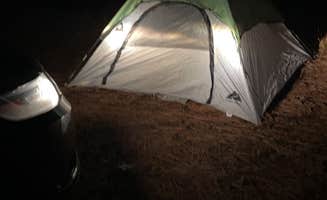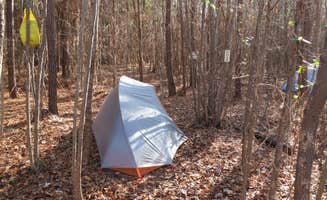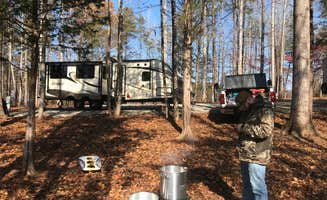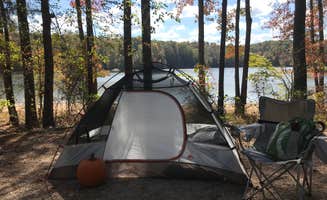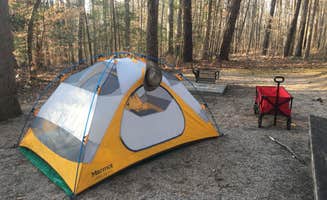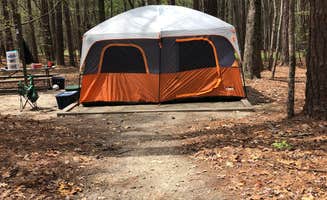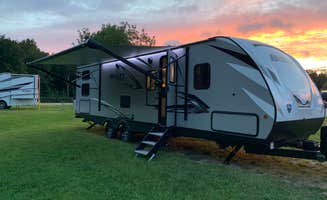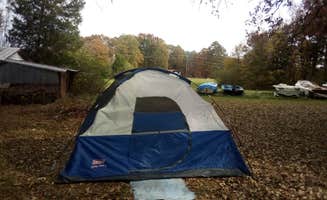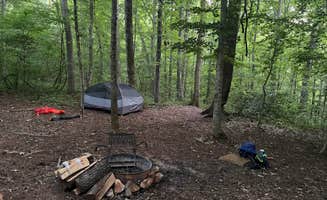Camping sites near Rougemont, North Carolina offer diverse experiences across state parks, wildlife management areas, and recreation areas within the Piedmont region. The area sits at elevations between 300-600 feet and experiences four distinct seasons with humid summers reaching 90°F and mild winters. Most camping areas in this region feature hardwood forests with oak, hickory, and pine trees creating varied terrain for different camping styles.
What to do
Hiking trails along waterways: Eno River State Park features extensive trail networks where visitors can experience nature up close. "We hike and swim Eno nearly weekly and are so thankful this resource is so close to us! We also backpack into the primitive sites frequently. We love the trails. The sites are always clean," writes Sarah W. about Eno River State Park Campground.
Water recreation options: Falls Lake offers multiple access points for swimming, fishing, and boating across its 12,000+ acre reservoir. According to a Mayo Lake visitor, "Lots of clearly marked hiking trails, 3 playgrounds, Frisbee golf and horshoe pits. Really preety and lots of boat docks," showing the variety of activities at Mayo Lake Park.
Educational programming: Several parks offer interpretive programs focused on local ecology. "We loved the educational experiences at this park. Very knowledgeable and clean," notes Elizabeth V. about Eno River State Park, highlighting opportunities to learn about local ecosystems while camping.
What campers like
Privacy levels between sites: The spacing between campsites varies significantly across different campgrounds. At Jordan Lake, Andrew S. notes, "There are TONS of spots that are right on the lake yet have plenty of trees for privacy. Each has a nice fire pit/grill and picnic table." Poplar Point Campground demonstrates how site layout affects camping experience.
Water views and access: Many campers appreciate direct lake access. "We had easy access to the lake from our camper where we did some kayaking. Priced extremely reasonable," shares one Mayo Lake Park visitor, highlighting how proximity to water enhances the camping experience without requiring additional travel.
Wildlife viewing opportunities: The region supports diverse wildlife. "We love seeing the wildlife," notes Sharon M. about Rolling View — Falls Lake, where campers can observe various birds and small mammals throughout their stay.
What you should know
Seasonal availability: Beyond the noted closures for Butner Lake WMA, other campgrounds have specific seasons. B.W. Wells at Falls Lake operates from "March 15 to November 30" and Holly Point from "March 15 to October 31," limiting camping options during winter months.
Permit and license requirements: Some areas require specific documentation. As noted by one camper at Butner lake WMA, "All Campers MUST have a fishers/hunters license." These licenses can be purchased at nearby retailers for approximately $30.
Limited cell service: Connectivity varies across campgrounds. A Mayo Lake Park camper warns, "If you have to have cell phone service it is very spotty," suggesting visitors should plan accordingly for limited connectivity in some areas.
Terrain challenges: Some campgrounds feature uneven terrain that can complicate camping setups. One visitor to Mayo Lake Park observed, "A lot of them are sloped. Very hard to level out a RV," indicating the importance of selecting appropriate sites based on equipment.
Tips for camping with families
Playground proximity: Several campgrounds offer play areas for children. At Holly Point — Falls Lake, Michelle M. recommends, "Great campground but we were limited due to rain! Nice secluded camping sites with space between. Large sites made it easy to set up multiple tents or camper and tent. Beautiful beach we didn't get to take advantage of but would love to go back!"
Swimming access: Designated swim areas provide safe recreation for families. "Very Family-friendly. It's best if you can get a site near the beach if you have kids Otherwise you'll end up driving them back-and-forth," advises Sherri P. about Holly Point.
Educational opportunities: Nature programs can enhance family camping experiences. "We hike and swim Eno nearly weekly and are so thankful this resource is so close to us!" mentions Sarah W., highlighting how regularly accessing outdoor recreation creates family traditions.
Tips from RVers
Road access considerations: Some campgrounds have challenging access roads. At Mayo Lake Park, a visitor cautions, "The road leading to the camping area is single lane so if you meet another camper going the other way it could get a little dicey."
Site selection for larger rigs: Not all sites accommodate larger vehicles. Timothy W. notes about B.W. Wells — Falls Lake, "The campground is primarily designed for small campers but there are a few spots that would accommodate campers in the 40 foot range," helping RVers identify suitable locations.
Utility placement: The location of hookups affects setup convenience. A Mayo Lake camper observed, "We also noted that our water and electricity was on the passenger side of our vehicle so it was a good thing we had an extra hose to reach the water as well as a long enough cord to reach the electric box," suggesting RVers should pack extension cords and hoses.


